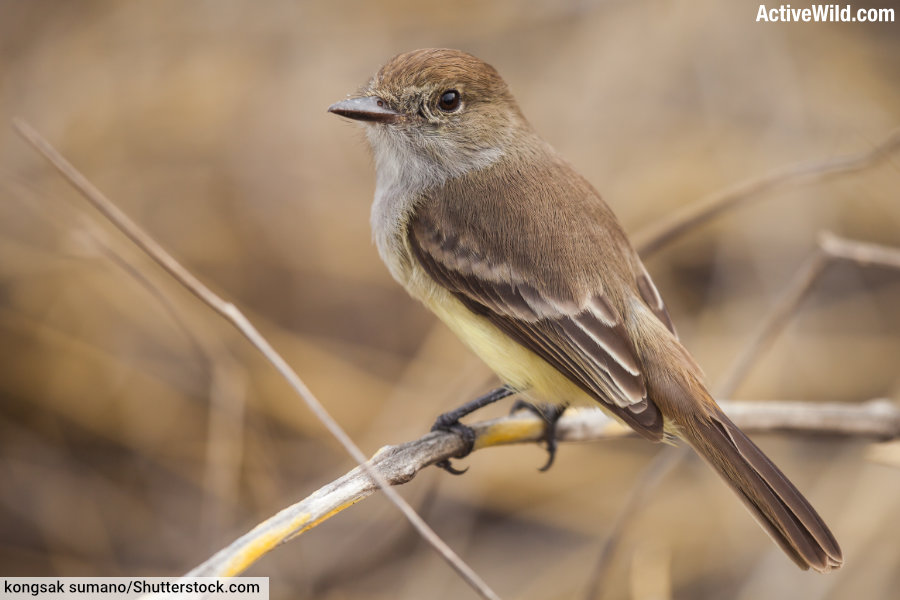
The Galápagos Islands are located in the Pacific Ocean, about 600 miles (970 kilometers) west of mainland Ecuador.
Due to their remote location, the Galápagos Islands are home to a large number of endemic animals; animals that are found nowhere else on Earth.
During his visit to the Galápagos Islands in 1835, naturalist Charles Darwin studied the islands’ unique animals, which provided inspiration for his groundbreaking theory of natural selection.
On this page, we’ll discover some of the Galápagos Islands’ most iconic species. All of the animals featured are endemic to the islands, and are therefore found nowhere else on Earth.
Watch the video below to see some of the amazing endemic species of the Galápagos Islands:
Galápagos Islands Animals List
Darwin’s Finches / Galápagos Finches

- Scientific name: Various
- Family: Thraupidae (Tanagers)
- Order: Passeriformes
- Class: Aves
- Conservation Status: Varies by species
Darwin’s finches are a group of around 18 species of small songbirds in the tanager family. All but one species (the Cocos finch) are endemic to the Galápagos Islands.
The plumage of Darwin’s finches is generally dull, with many species being brown or gray.
These otherwise unremarkable birds are famous for their role in inspiring Charles Darwin’s theory of evolution by natural selection. The famous naturalist noticed that some of the finches had strong, broad beaks for cracking seeds, while others had slender, pointed beaks for catching insects or for feeding on nectar.
Darwin theorized that the different finch species had evolved from a single ancestral species, with each modern species having evolved special adaptations for a particular diet.
Flightless Cormorant
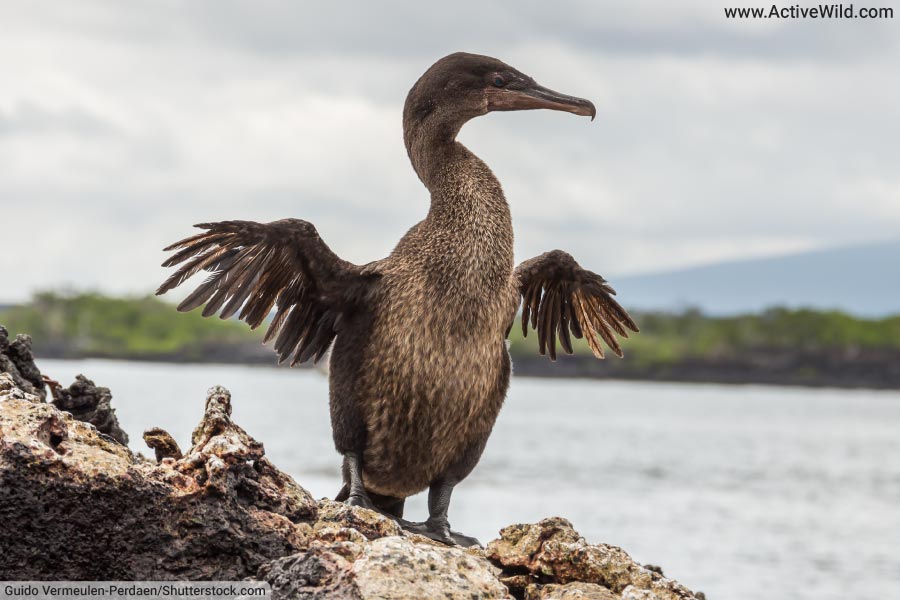
- Scientific name: Nannopterum harrisi
- Family: Phalacrocoracidae (Cormorants & Shags)
- Order: Suliformes
- Class: Aves
- Conservation Status: Vulnerable
The flightless cormorant is one of the world’s rarest seabirds, with a total population of around 2,000 individuals, all of which are found on the Galápagos Islands.
The flightless cormorant has small, stubby wings and, unlike other cormorants, is unable to fly. Instead, it relies on its excellent swimming and diving abilities. It has strong, webbed feet and a streamlined body.
The flightless cormorant evolved in an environment with no notable land predators, and, like several other Galápagos Island animals, has very little fear of humans.
The flightless cormorant feeds on fish, octopuses, eels, and other marine life. It lives along rocky shores, particularly on the islands of Fernandina and Isabela. Here, it builds bulky nests out of seaweed and debris.
During the mating season, the male cormorant presents the female with gifts of seaweed and other nesting items.
Galápagos Dove

- Scientific name: Zenaida galapagoensis
- Family: Columbidae
- Order: Columbiformes
- Class: Aves
- IUCN Conservation Status: Near Threatened
The Galápagos dove is a small member of the pigeon and dove family, Columbidae. Although capable of flight, it spends much of its life on the ground.
The dove is easily recognizable by its reddish-brown plumage, spotted with white on the wings, red legs, long bill, and distinctive blue eye rings. Its back is a darker brown, while its underside is paler.
This species is commonly found on arid parts of the Galápagos Islands, where it forages on the ground for seeds, fruits, and occasionally small invertebrates. Its long, curved bill is an adaptation for foraging in the soil.
The Galápagos dove will feign injury to lure a predator away from its nest.
Galápagos Flycatcher / Large-Billed Flycatcher

- Scientific name: Myiarchus magnirostris
- Family: Tyrannidae
- Order: Passeriformes
- Class: Aves
- IUCN Conservation Status: Least Concern
The Galápagos flycatcher, also known as the large-billed flycatcher, is a small, active bird found throughout the Galápagos Islands. Its large, broad, slightly hooked beak is an adaptation for capturing insects. Its plumage is primarily brownish-gray on the back with a paler, yellowish underbelly. The tail is relatively long and slightly rufous in color.
An insectivore, the Galápagos flycatcher actively forages by darting from perches to catch flying insects, which it skillfully snatches in midair or from vegetation. It is known for its bold behavior and curiosity, often approaching humans closely. The bird also feeds on small fruits, especially during the dry season when insects are less abundant.
Galápagos Fur Seal
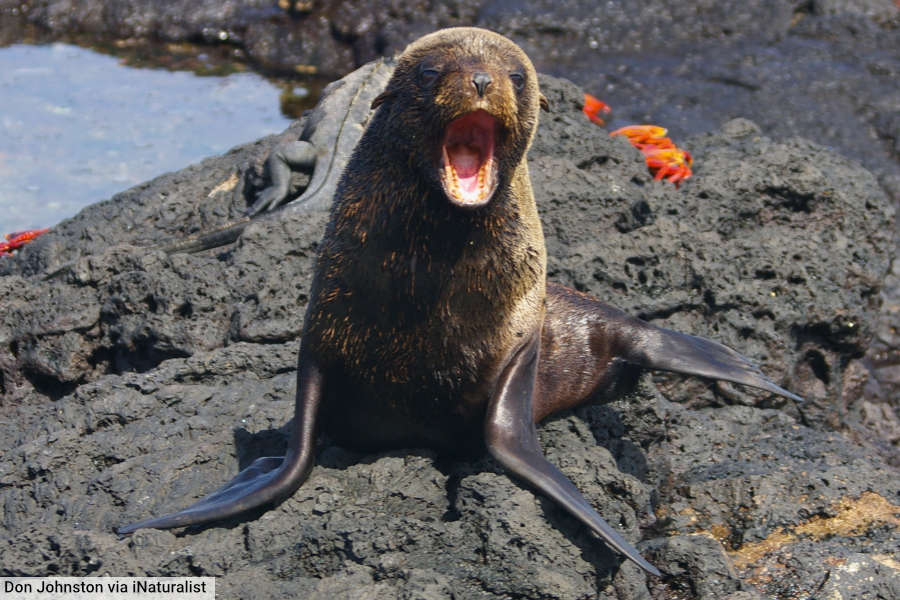
- Scientific name: Arctocephalus galapagoensis
- Family: Otariidae (Eared Seals)
- Order: Carnivora
- Class: Mammalia
- Conservation Status: Endangered
The Galápagos fur seal is the smallest member of the eared seal family, which includes fur seals and sea lions. Male Galápagos fur seals are typically around 5 feet (1.5 meters) in length and weigh around 130 pounds (60 kilograms), and can be twice the size of females.
Like other fur seals, the Galápagos fur seal has a layer of thick fur. This provides the mammal with insulation in the relatively cool waters of the Galápagos Islands. The seal is mainly nocturnal, its large eyes helping it to see while hunting for prey such as fish and squid.
The Galápagos fur seal spends almost a third of its time out of the water – a larger proportion than any other eared seal. It tends to avoid humans and is more reclusive than its island cousin, the Galápagos sea lion, which we’ll meet further down the page.
Galápagos Hawk
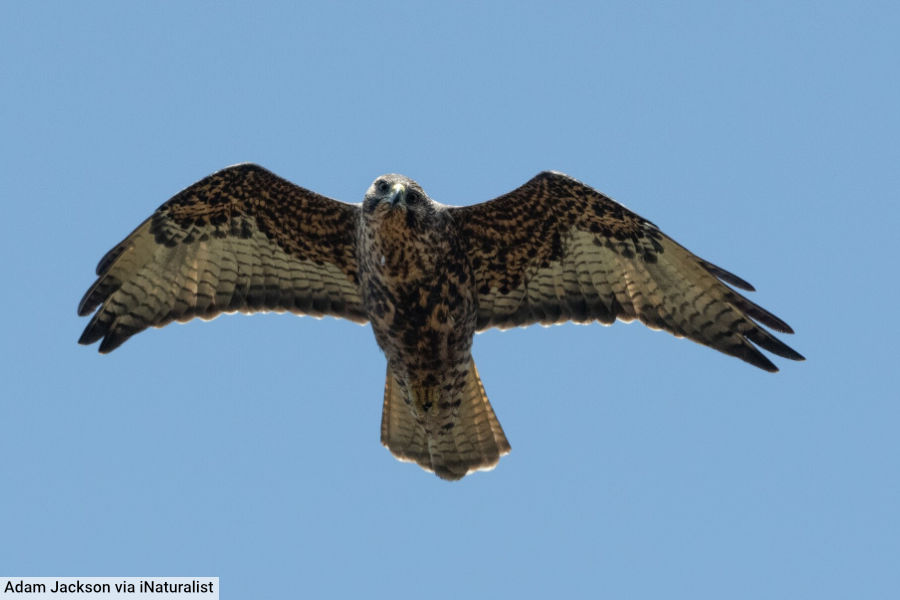
- Scientific name: Buteo galapagoensis
- Family: Accipitridae
- Order: Accipitriformes
- Class: Aves
- IUCN Conservation Status: Vulnerable
The Galápagos hawk is an apex predator in the Galápagos Islands. This large bird of prey has a wingspan of around 120 cm and is equipped with strong talons and a hooked beak for catching prey.
A carnivore, the Galápagos hawk preys on a wide variety of animals, including insects, reptiles, birds and small mammals. Several of the other animals on this list of Galápagos Islands animals feature in the hawk’s diet, including the large painted locust, Galápagos dove, Galápagos mockingbird, lava lizard, racer snake and swallow-tailed gull. It will also eat carrion.
The hawk is known for hunting in cooperative groups, with several birds working together to locate prey using their excellent eyesight.
Galápagos Land Iguana

- Scientific name: Conolophus subcristatus
- Family: Iguanidae (Iguanas & Relatives)
- Order: Squamata
- Class: Reptilia
- Conservation Status: Vulnerable
The Galápagos land iguana is one of the world’s largest lizards. It typically grows up to 5 feet (1.5 meters) in length and weighs around 24 pounds (11 kilograms). It has rough, scaly skin, which ranges from yellowish-orange to brownish-black. The iguana has a crest of spiny scales running along its back and neck, giving it a prehistoric appearance.
Despite its fearsome looks, the Galápagos land iguana is primarily herbivorous. Its favorite food is prickly pear cactus, which also provides the reptile with water.
The Galápagos land iguana lives in dry habitats, and this cold-blooded animal is often seen basking in the sun to regulate its body temperature. During the hottest parts of the day, it seeks shade under rocks or plants.
Galápagos Lava Lizard
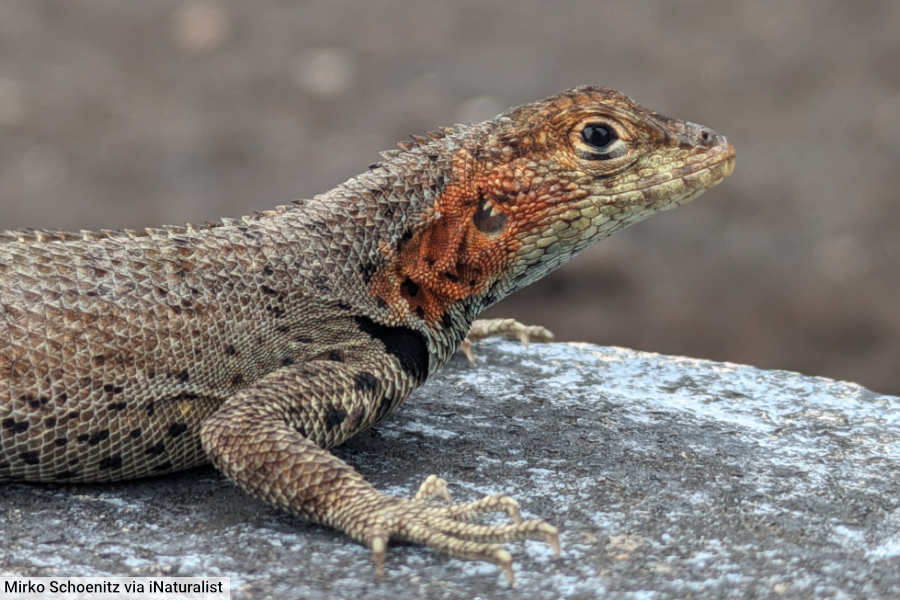
- Scientific name: Microlophus albemarlensis
- Family: Tropiduridae (Neotropical ground lizards)
- Order: Squamata
- Class: Reptilia
- Conservation Status: Least Concern
The Galápagos lava lizard is one of ten species of lava lizard endemic to the Galápagos Islands, and is found on several islands in the archipelago.
The Galápagos lava lizard is a small reptile, typically reaching lengths of 4 to 7 inches (10 to 18 centimeters), including its long, slender tail. It has a varied coloration that allows it to blend with the volcanic rocks of the Galápagos Islands, ranging from mottled brown to gray. Males often have yellow-gold stripes, while females have a reddish-orange throat.
The species is primarily insectivorous, feeding on ants, flies, and beetles. It also eats small amounts of plants and seeds.
The Galápagos lava lizard is known for its distinctive territorial displays, in which males perform “push-ups” to establish dominance and deter rivals.
The Galápagos lava lizard plays an important role in the Galápagos food chain both as predator of insects and as prey to animals such as snakes, scorpions and birds. It is capable of changing color for camouflage, and can also detach its tail to evade predators.
Galápagos Mockingbird
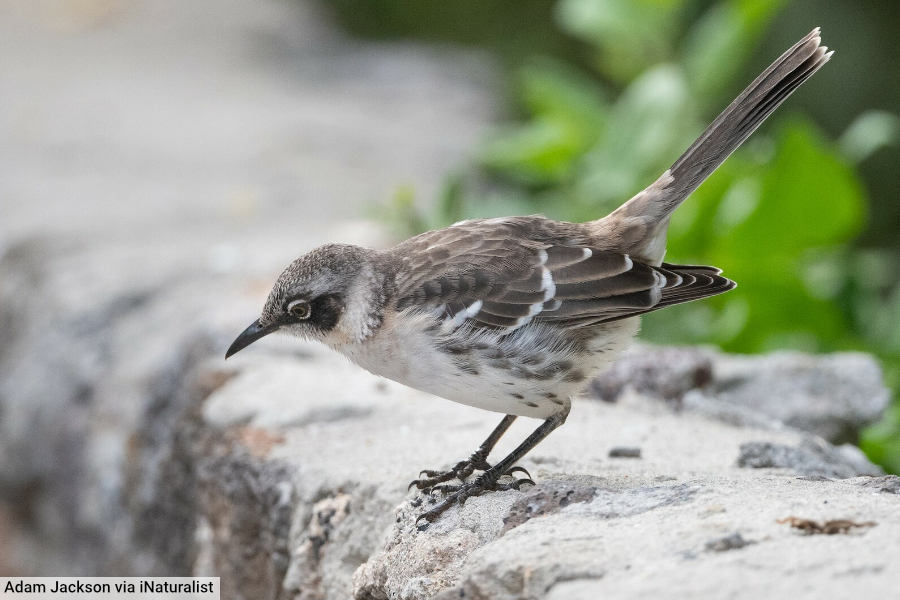
- Scientific name: Mimus parvulus
- Family: Mimidae (Mockingbirds, Thrashers & Related)
- Order: Passeriformes
- Class: Aves
- Conservation Status: Least Concern
The Galápagos mockingbird is one of four mockingbird species endemic to the Galápagos Islands, and the most widespread. It is medium-small, long-legged bird, with grayish-brown plumage, a long tail, and distinctive white streaks on its wings. Like many mockingbirds, the Galápagos mockingbird has a slender, downward-curved beak.
The mockingbird’s behavior is highly inquisitive and bold. It will often approach humans closely, a trait that fascinated early naturalists like Charles Darwin.
The Galápagos mockingbird is a generalist omnivore, consuming insects, fruits, seeds, and even carrion. It is known for its opportunistic foraging behavior, sometimes stealing eggs or even preying on small animals like baby sea turtles.
The Galápagos mockingbird lives in family groups that are strongly territorial.
Galápagos Penguin
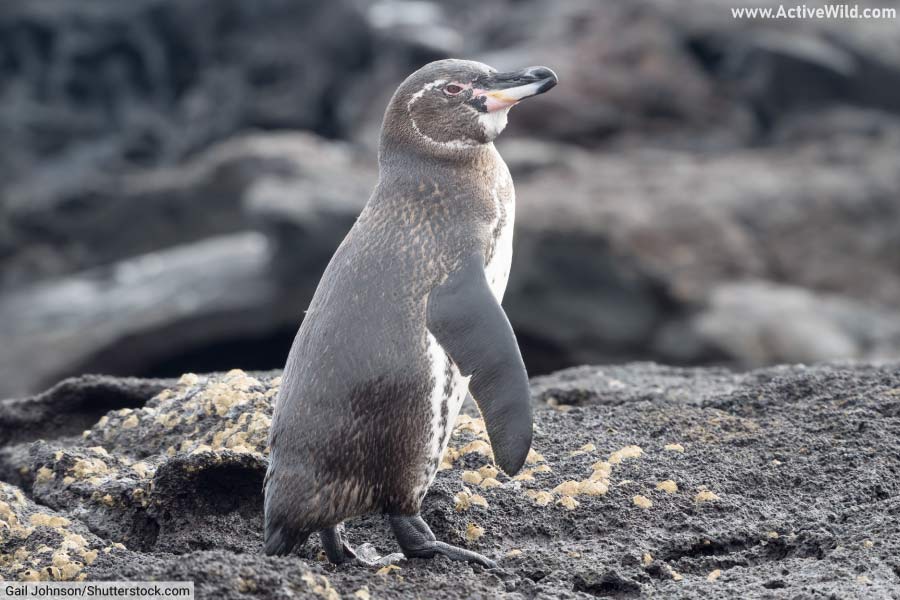
- Scientific name: Spheniscus mendiculus
- Family: Spheniscidae (Penguins)
- Order: Sphenisciformes
- Class: Aves
- Conservation Status: Endangered
The Galápagos penguin is the only penguin found in the northern hemisphere. It is mainly found around Fernandina Island and Isabela Island.
One of the smallest penguin species, the Galápagos penguin stands about 20 inches (49 centimeters) tall and weighs around 5.5 pounds (2.5 kilograms). It has the classic penguin black-and-white coloration, and has a narrow white stripe running from its eye to the chin, and a black band running along the sides and top of its breast.
When swimming, the penguin’s dark back provides camouflage from above, while its lighter underside protects it from predators below.
The Galápagos penguin hunts in the cool, nutrient-rich waters of the Humboldt and Cromwell currents. It feeds mainly on small fish such as sardines and mullet, and hunts during the day.
The Galápagos penguin mates for life. It forms small colonies for breeding, often nesting in crevices or lava caves to escape extremes of temperature.
Galápagos Racer
- Scientific name: Pseudalsophis biserialis
- Family: Colubridae
- Order: Squamata
- Class: Reptilia
- Conservation Status: Near Threatened
The Galápagos racer is one of only three snake species in the Galápagos. It is a slender, mildly-venomous snake, typically growing up to 4 feet (120 centimeters) in length. It has a brown or grayish body with subtle stripes or patterns that provide camouflage among the rocks and dry vegetation of the islands.
This snake is an active predator, feeding on small mammals, lizards, insects, and occasionally the hatchlings of birds and marine iguanas. It is known for its speed and agility, both on the ground and when navigating rocky terrain.
The snake’s population is threatened by introduced predators such as rats and feral cats.
Galápagos Rice Rat
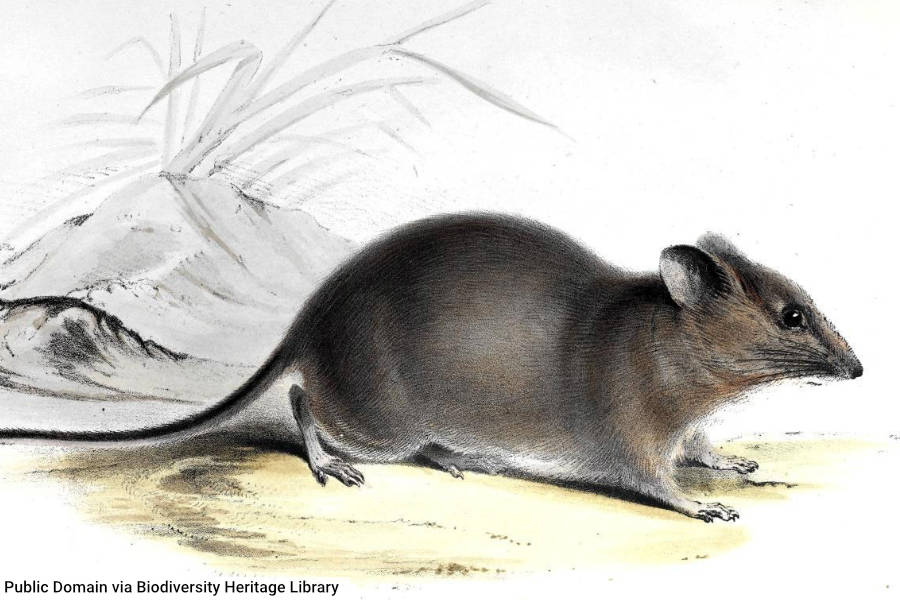
- Scientific name: Aegialomys galapagoensis
- Family: Cricetidae
- Order: Rodentia
- Class: Mammalia
- Conservation Status: Vulnerable
The Galápagos rice rat is a small, nocturnal rodent found on Santa Fé Island, one of the smaller Galápagos islands. It typically measures about 6 to 8 inches (15–20 centimeters) in body length, with a tail roughly the same length.
Its soft, brownish-gray fur helps it blend into its dry, scrubby environment.
Primarily herbivorous, the Galápagos rice rat feeds on seeds, fruits, and vegetation, although it occasionally consumes insects and small invertebrates.
The Galápagos rice rat is largely solitary, emerging at night to forage, and it nests in burrows or crevices for protection during the day.
The species faces significant threats from introduced predators such as cats and rats. Today it is only known to be present on Santa Fé Island, having become extinct on San Cristóbal Island several decades ago.
Galápagos Sea Lion
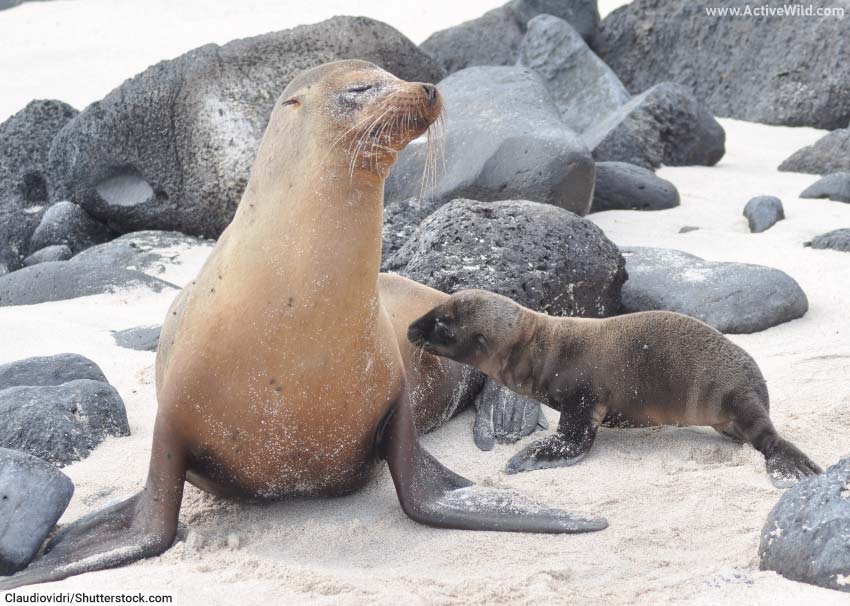
- Scientific name: Zalophus wollebaeki
- Family: Otariidae (Eared Seals)
- Order: Carnivora
- Class: Mammalia
- Conservation Status: Endangered
Although also found on Ecuador’s Isla de la Plata, and therefore not quite endemic to the Galápagos Islands, we have included the Galápagos sea lion on this list as it is one of the islands most iconic animals.
This marine mammal is a common sight on the islands’ beaches and rocky shorelines.
Despite being the world’s smallest sea lion species, very large adult male Galápagos sea lions can reach lengths of up to 8.2 feet (2.5 meters) and weights of up to 880 pounds (400 kilograms). Females are considerably smaller than males, typically weighing around 220 pounds (100 kilograms).
Like other members of the eared seal family, the Galápagos sea lion has external ear flaps and hind flippers that can turn forwards to facilitate walking on land.
The Galápagos sea lion feeds on fish, squid, and other marine creatures. It is a skilled swimmer, using its powerful front flippers to propel itself through the water.
Galápagos Tortoise
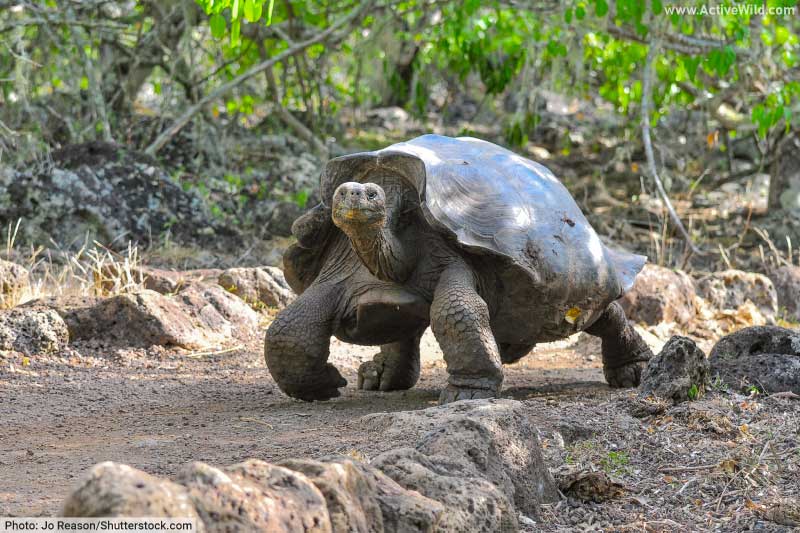
- Scientific name: Chelonoidis niger
- Family: Testudinidae (Tortoises)
- Order: Testudines
- Class: Reptilia
- Conservation Status: Populations range from Vulnerable to Critically Endangered
The Galápagos tortoise is the largest living species of tortoise, with some individuals growing over 6 feet (1.8 meters) in length and weighing over 880 pounds (400 kilograms).
This huge reptile is the world’s largest living cold-blooded land animal. It basks in the sun for at least an hour in the morning to warm up its giant body.
The Galápagos tortoise has a lifespan of well over 100 years, with some individuals estimated to be more than 170 years old.
The Spanish explorers who discovered the Galápagos Islands named them after the giant tortoises: “galápago” means “tortoise” in Spanish.
The shells of Galápagos tortoises vary in shape depending on the island on which they are found, with some populations having “saddleback” shells, which arch upwards at the front, and others having domed shells.
The Galápagos tortoise is primarily herbivorous, feeding on grasses, cacti, and fruits.
Large Painted Locust
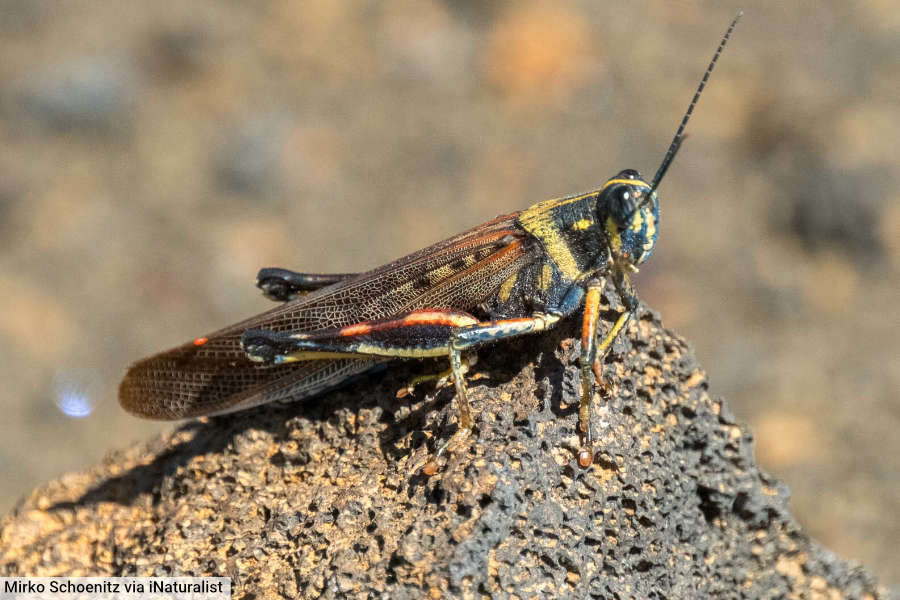
- Scientific name: Schistocerca melanocera
- Family: Acrididae
- Order: Orthoptera
- Class: Insecta
- IUCN Conservation Status: Not Evaluated
The large painted locust is a striking insect found in the Galápagos Islands. It is notable for its vivid coloration, with bright yellow and green body patterns accented by black markings. Its hind legs are powerful, allowing for strong, long-distance jumps, and it has transparent wings with a slight tint, used for short flights when necessary.
This locust is primarily herbivorous, feeding on the leaves, flowers, and fruits of various plant. Its bright colors may serve as a warning to potential predators about its unpleasant taste.
The large painted locust is a food source for many endemic Galápagos animals, such as the Galápagos hawk, mockingbird and lava lizards.
Marine Iguana
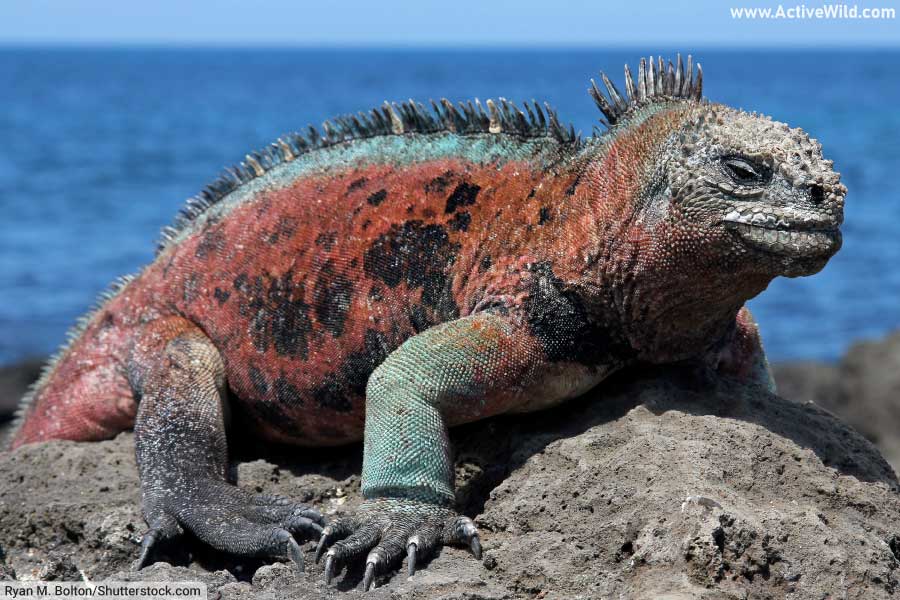
- Scientific name: Amblyrhynchus cristatus
- Family: Iguanidae (Iguanas & Relatives)
- Order: Squamata
- Class: Reptilia
- Conservation Status: Vulnerable
One of the Galápagos Islands’ most unusual animals is the marine iguana. It is the only lizard in the world that has adapted to a marine lifestyle.
The marine iguana feeds on algae, diving into the ocean to graze off underwater rocks. Its flattened tail and sharp claws aid in swimming and clinging to rocky surfaces.
The marine iguana expels excess salt from its body through special glands located near its nostrils, often producing a distinctive “sneezing” sound while doing so.
This unique reptile grows up to 4.6 feet (1.4 meters) in length, and most individuals have dark, or black skin, although some populations are more colorful. Males develop reddish or greenish hues during the breeding season.
The dark color of the skin helps the cold-blooded lizard to absorb heat after swimming in the cool waters around the islands–after emerging from the water, the iguana basks in the sun to warm up.
Swallow-Tailed Gull

- Scientific name: Creagrus furcatus
- Family: Laridae
- Order: Charadriiformes
- Class: Aves
- IUCN Conservation Status: Least Concern
The swallow-tailed gull is a striking seabird mostly endemic to the Galápagos Islands, but also found in very small numbers on Colombia’s Malpelo Island. This distinctive gull species is easily recognizable by its deeply forked tail and distinctive red eye rings. It is medium-sized, with a wingspan of about 1 meter. Its head is black during the breeding season, and white at other times of the year.
This gull is the only nocturnal gull in the world, feeding primarily at night. Its diet consists of squid and small fish, which are attracted to the surface by bioluminescent organisms.
The swallow-tailed gull has the largest eyes of any gull. In addition, and like many nocturnal animals, its eyes are equipped with a tapetum lucidum – a reflective layer behind the retina that improves night vision. These adaptations allow the gull to hunt in the dark ocean waters.
The swallow-tailed gull nests in colonies on rocky cliffs, often choosing inaccessible ledges to protect its eggs from predators.
Conclusion & Further Reading
We hope that you enjoyed learning about the amazing animals of the Galápagos Islands. Let us know your favorite animal in the comments below!
Discover more animals on the following pages:
- You can see more South American animals on this page: South American Animals
- Visit our main animals page for links to animal information and a complete guide to the animal kingdom: Animals
The post Galapagos Islands Animals: Interesting Species Found On The Islands appeared first on Active Wild.